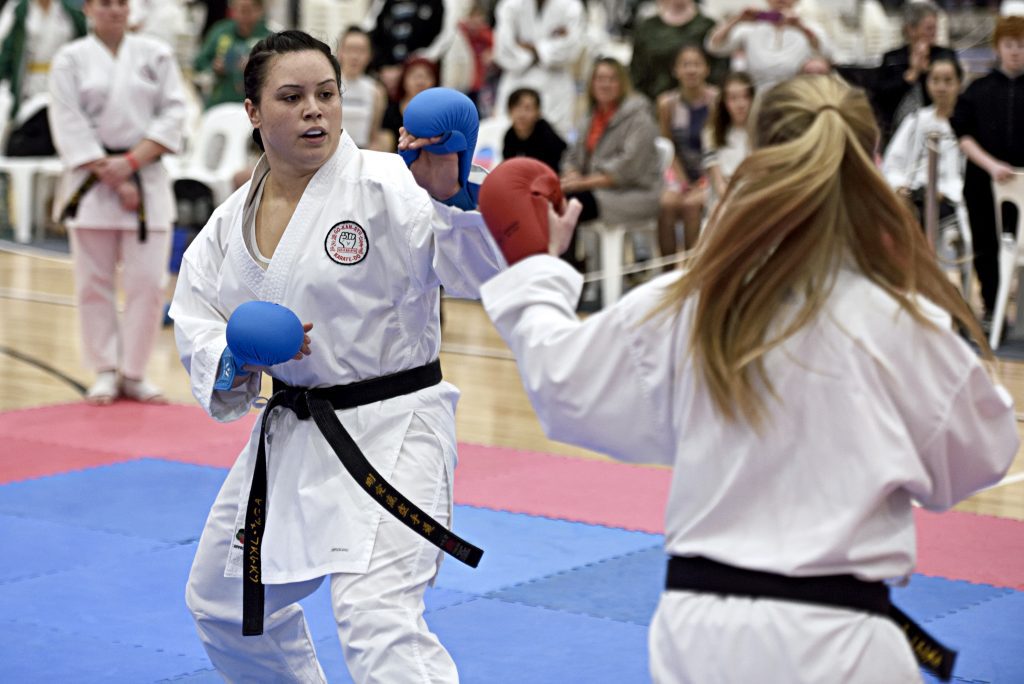Improving your Style of Kumite
GKR practitioner’s come in many shapes and sizes. Some pick up sparring like a duck to water while to many others it is something that starts out feeling very unnatural. Learning techniques is one thing, but successfully putting them into practice in a semi-realistic situation or developing a successful strategy to do so is another.
Because of this, many people may feel lost when it comes to sparring; even more so when their role models may be much bigger and stronger than they are making it almost impossible to emulate them. You may ask questions such as, “Is there a correct approach or method of sparring that we all should use?” “Do we try to emulate our instructor? Or Kancho Sullivan?”
The answer to these questions are ‘yes’ and ‘no’. I do believe that on many levels we should model the style of kumite that we see our instructors perform. I also believe that there are basic kumite philosophies that Go-Kan-Ryu and many other traditional styles promote that should be taken on board by a student who is trying to develop their kumite. It is, for this reason, we are taught similar techniques in class – similar attacks, counter-attacks, footwork drills etc.
In the end, however, there is no correct approach or method of sparring that a practitioner should adopt. The reality is that kumite is a form of self-expression. One key reason that there is no one style of kumite is that there is no one style of the practitioner. Some are tall, others are small, some are flexible, and others are not. Some people are physically strong and heavy while others may lack real strength and are light by comparison. Because of this, what may work for one person may be ineffective for another.
Becoming Multi-styled
A philosophy many martial artists take on board is that not only are there different styles of kumite for different people, but there should also be different styles for one person.
It has been said many times in martial art circles that ‘a light wind can push grass around, but against an oak tree it has no effect at all. The oak stands strong and proud. Yet a strong wind can uproot the oak tree, but even the strongest winds cannot uproot the grass which just moves to and fro in its force’. The key is that a karate-ka at times must be like grass and other times like the oak. Too often, however, a karate-ka takes on board one style of kumite and refuses to adopt new styles. Bruce Lee spoke of the dangers of this when he said, “When a person is bound by a set pattern of ideas or way of doing something, they stop growing”. Kancho Sullivan shares this philosophy. and states “We as people never stagnate, we are always going forwards or backward. Even if we think we are stagnating, the fact that others around us are moving forward has the same effect, we end up behind”.
First Things First
While it is important to adopt a number of styles for our own kumite, it is essential that one first adopts their own ‘one’ style. Only after a person has a style they feel comfortable with, can they become confident in kumite and then start to expand their horizons.
Now when it’s said that you must adapt your own style, it does not mean you need to invent techniques or new and interesting stances. It just means you need to adapt your strategies for kumite. It also means you need to look at yourself and find your strengths and bring them into the forefront of your Kumite while understanding your weaknesses and keeping these to the back. This is why we said earlier that first establish one style to gain confidence, then you can expand your horizons. An example of this can be found one of our students many years ago. Her name was Cindy and she was 17 years old. Constantly taking on grown men in the class (who often were twice her weight) it was understandable she was always uncomfortable sparring and often asked them to go very easy on her. We established she was very good with her right hand, when it came to both blocking and punching, but her left hand was light years behind. Cindy began to work sparring with her right foot forward so her right hand could be at the front to block. We had her work on blocking only to develop confidence in her defences. Then later we added counter-attacking, but with the same arm. She became very proficient in blocking and countering with her right arm only. She was light and quick and could get in and out before the bigger men could reply to her counter. This style of kumite limited her as a martial artist but built her confidence to get in a spar freely. Once she became confident with this we started adding a left counter punch and attacking more. In the end she became confident and could spar with either foot forward, and freely attack or counter attack. Because of her small size however, regardless of which style she adopted at the time, she was always like grass, constantly moving around and using her speed to get in and out.
‘Kantan Na Mono Yoku Sho O Seisu’
Where we have said that people’s approach to kumite may, and should, differ, the techniques people use should basically be the same. That is, a punch or kick has good form and comes from a good stance. A karate-ka spends many hours going over the basic techniques so that they become embedded in the subconscious. When this happens, during kumite a person can concentrate on what they will do and the how takes care of itself.
This does not mean that a person should use all the techniques they practice; it just means that what they use should follow that which they are taught. When one is looking for their strengths and weaknesses, it is here that they can decipher which techniques they will mostly use. There is a Japanese karate saying which is ‘Kantan na mono yoku sho o seisu’ which means “the difference between victory and defeat hangs on simple matters”. This tells us that in a real life situation, or in kumite is not how many techniques we know that will see us through, but developing excellent timing, distance and focus in the few techniques we do perform.
Bruce Lee once wrote on such a topic; “A few simple techniques, well presented, with an aim clearly seen, are better than a tangled maze of data whirling in disorganized educational chaos”. “It is not a matter of daily increase, but daily decrease. Hack away the unessential”. “To get better don’t complicate things, improvement is often as simple as to simplify”.
So we understand that there is no real style or method of kumite that a person who practises Go-Kan-Ryu should follow. All are free to develop what works best for them. Some will be strong attackers, while others may counter or pick their opponents off. Some will use many punches, others many kicks, while others will use just one single, powerful punch. Some will stand strong, others will move and be light-footed. Whatever style one chooses, there are basic philosophies towards kumite that anyone can benefit from.




